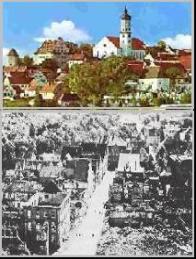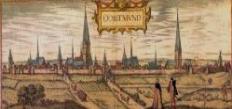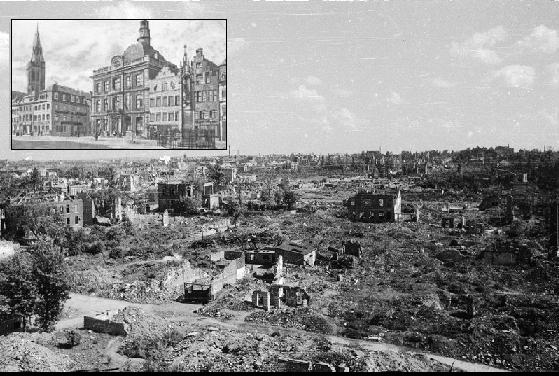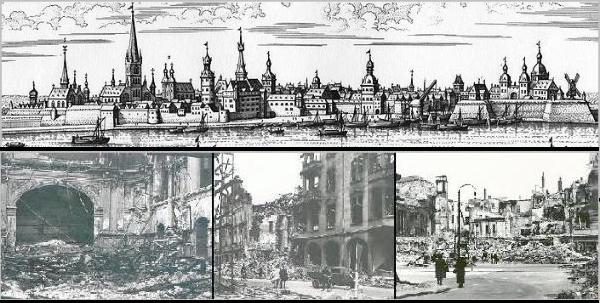
Darmstadt produced less than two-tenths of one percent of Germany’s total war production, yet a minimum of ten percent of Darmstadt’s civilian population died from the intentionally created firestorm that utterly destroyed the city.
More on Darmstadt Hurdy-Gurdy Girls
Allied air attacks heavily destroyed Datteln’s residential area. The worst attack was on March 9, 1944 by 77 RAF Halifax Bombers. They destroyed the churches, including St. Amanduskirche, 3 schools, several buildings of the local mine and 12% of the houses. 64% of the remaining homes were gravely damaged. There were a number of dead civilians who were buried in a mass grave. All the bridges were blown up by Allied troops.
Between 1940 and 1945, Dessau had 20 Allied air attacks beginning in 1940, but the bombing on March 7, 1945 sent it into rubble and ash. Out of the red sky, from the mouths of 520 Royal Air Force Lancasters and 5 Mosquitos, fell 1,693 tons of bombs, of which about 800 were high explosives and 600,000 were incendiary bombs dropped in three waves of attack, all intended to assist the Red Army. Dessau was 84% destroyed and 1,136 civilians lost their lives.
Nearby Zerbst is located about halfway between Magdeburg and Dessau in the district of Anhalt. The town is first mentioned in the chronicle of Thietmar of Merseburg in 1018 and after the Reformation, from 1582 to 1798, it became a center of Calvinism in Germany. It is best known for Princess Sophie Auguste Friederike von Anhalt-Zerbst who became known as Catharine the Great of Russia and her manor home was in Zerbst.
On April 16, 1945, mere weeks before the final surrender of Germany, eighty percent of Zerbst was destroyed by Allied bombing. Zerbst was pummeled by four or five waves of 20 to 60 aircraft each for an estimated 40 minutes. The city was teeming with refugees fleeing from the east and wounded soldiers. 574 people were killed by bombing. The Americans were the first to occupy the city and handed it over to the Russians the following month. Only a few historical structures being preserved.
Construction of Zerbst Palace was first begun in the year 1196 and it was expanded and improved in 1681 by Prince Karl Wilhelm of House of Anhalt-Zerbst. In the bombing of April 16, 1945, the castle was bombed and burned out completely destroying the precious interior as well as the exhibits in the museum and the documents held in the State Archives. Reconstructing the palace would have been possible, but this option was rejected by the communists for ideological reasons.

|
| Above, Dessau. Below, Zerbst Palace |

|
From 1940 to 1945 numerous Allied bombing raids took place on the village of only 1,400 inhabitants because of the nearby oil refinery, killing 12 civilians and several foreign farm workers. There is a Memorial in the village and several of their graves. At the War Memorials there are 28 names of native sons lost in World War One and 49 from the Second World War. The town was first occupied by the Americans, then the British.

His progeny forgot this when on April 11 and 19, just weeks before the end of the war in 1945, last minute insane attacks took place on an unprepared population. Donauwörth was attacked and 75% of the town was utterly destroyed.

Approximately 5,600 Allied bombs in March 1945 destroyed the town by 80%: St. Agatha Church, parts of which dated to 1170, the Franciscan Monastery of St. Anna from 1488, Magdalene Chapel from 1488, the Ursuline convent founded in Cologne in 1699, Ursulinenkirche from 1707, the Dorsten Rathaus, the Siechenkapelle (with hospital) from the 14th century, and hundreds of timber-framed buildings. 2,959 buildings were lost. It took three years, until 1948, to clear the debris.


Like the rest of the Ruhr, Duisburg’s industries made it a primary target of Allied bombers, but the residential areas were attacked with equal vengeance. Starting in 1941, there were daily bombing raids as British bombers drop a total of 445 tons of bombs. In July of 1942, another attack took place. In 1943 1,599 more tons were dropped. By then 96,000 people were homeless. Another 2,000 tons were dropped in 1944, and then doubled to 4,000 tons again in 1944. In one massive assault, 2,000 bombers attacked at once, dropping 9,000 bombs and killing 3,000 more civilians. Attacked repeatedly, the city was under constant barrage until April 3, 1945. A grand total of 299 bombing raids had all but completely destroyed the historic cityscape. 80% of all residential buildings were lost.

On November 16, 1944, the sky over Duren filled with bombers overloaded with incendiaries and high explosive bombs as part of a lethal joint British-American operation called “Operation Queen.”A few quick snaps and the town was engulfed in a tower of fire, houses collapsed into rubble, and the tar on the roads became so hot that the soles of shoes stuck to it. 1,204 heavy US bombers joined 498 British bombers, and within two hours dropped over 9,000 tons of bombs on the ancient town. The idyllic city life as well as the beautiful, old buildings were obliterated. Of 45,000 humans who lived there, 3,127 who didn’t evacuate in time were painfully extinguished.
The aerial mines sucked off rooftops, opening the houses up for total destruction from within and without by the heavy pounding of heavy, high-explosives bombs, which brought the houses to their helpless collapse and broke water, sewer and gas pipelines, while smaller high-explosives bombs spread panic and forced people into cellars. Afterward, the release of heavy liquid incendiary bombs created fire towers and suffocated those who fled below ground. Burning phosphorus, which turned people into living candles, blanketed any area of possible escape. Duren had 6,431 houses before the assault, and only 131 after. The whole medieval core of town was totally destroyed. There is no building in Duren today which dates from before 1945/46. Above: Duren marketplace, before, after
Also destroyed or damaged during this operation were several surrounding towns and villages. The 8th U.S. Air Force hit the three towns of Eschweiler, Weisweiler and Langerwehe with 4,120 bombs. 339 fighter bombers of the 9th U.S. Air Force attacked Hamich, Hürtgen and Gey with 200 tons of bombs. Gey was a town located at the outskirts of the beautiful Hürtgen forest, situated in a valley through which all roads leading from the forest intersect. The forest is about twenty miles long and ten miles wide, just a few miles from Aachen and Düren. It is accented with steep gorges and winding slopes covered with thick layers of evergreens and firs. There was heavy fighting in the war here after it was bombed during “Operation Queen.”
Among the many towns also bombed in “Operation Queen” was Aldenhoven whose history goes back 4,000 years before the birth of Christ. The still well-preserved castles in the towns and Dürboslar Engelsdorf date from 898 and 1080. There was a 12th century church (only parts of it stand today) and in the neighboring village of Siersdorf was one of the most important branches of the Teutonic Order. This incredibly destructive and yet militarily ineffective bombing operation destroyed the ancient city of Jülich as well because of faulty information.

Round the clock air attacks and a 2,000 ton raid reduced Düsseldorf to rubble. Starting from May 1940 there were numerous air raids, but without substantial casualties. In 1942, attacks increased and whole bomber fleets were set on the city. Large-scale attacks took place on July 31 and August 1, 1942 leaving 290 dead over 1,000 missing. The old city center was attacked on November 10, 1942, leaving 132 dead and 550 injured. Image: Düsseldorf 1647 and 1945. Further large-scale attacks on January 27, 1943, June 12, 1943, April 22, 1944 and April 24, 1944 killed around 1,000 people. 243 attacks were counted in total, killing 6,000 civilians and destroying over 176,000 dwellings, all three Rhine bridges, numerous roads, as well as the drainage system, leaving behind 10 million cubic meters of rubble. Only 10% of buildings were undamaged. The number of inhabitants plummeted from 540,000 in 1939 to approximately 235,000 in 1945.